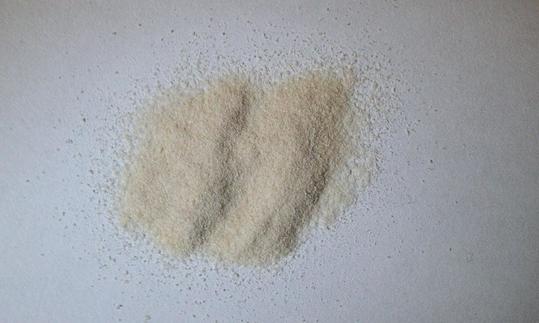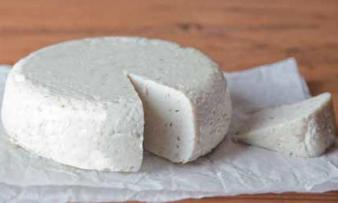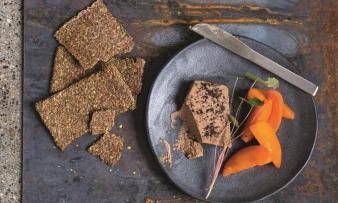Table of contents
Agar-agar, made from seaweed, is often used as a plant-based equivalent of gelatine and is also used in research and medicine. It is available organically, but cannot be used raw or in its raw form, as it only gels during the cooking process.
Use in cooking
Agar comes from agar-agar, the Malay term for gelling food. Agar, which is obtained from dried seaweed, is a galactose polymer made from agarose and sulfated agaropectin. It is derived from the cell walls of dried red algae species, mainly from the genera Gracilaria, Gelidium, 1 Pterocladia, Gelidiella and Gigartina 2. The latter type is more commonly used to produce gelling agents such as carrageenan. 2
Agar is a beige-coloured, tasteless powder and is listed in the EU as a food additive under the number E 406. 7 Agar-agar is used primarily in the food industry: in bakeries, agar is used to coat cakes and glaze doughnuts. When applied to chocolate, it ensures that it does not break quickly. In general, agar prevents baked goods and sweets from drying out. The sweets industry uses agar to make jellies, marshmallows and candies. Its role in the production of fruit gums is particularly important. Agar-agar is also used to clarify fruit wine (must) and as a carrier for flavours or additives.
Agar-agar is suitable for use in the preparation of jellies, cake glazes, creams or desserts such as pudding or panna cotta. It is also used in the production of coconut yogurt and vegan almond cheese as a thickener or in soy whipped cream as a stabilizer. Because it is taste-neutral, it is also used to thicken sauces for savory dishes.
Since the 17th century, agar has been present in various dishes in Japan and China. Examples include tokoroten noodles or desserts such as mitsumame, a fruit salad with seaweed cubes. To ensure that these dishes neither melt nor crumble, certain Gelidium algae are used.
It is sold commercially under the name agar-agar, mainly in powder form or flakes. It is also available in sheet form and is a popular vegan alternative to animal gelatin. In comparison to other vegan binding agents, such as pectin, agar does not require sugar to form a gel.
Making your own agar-agar
The gelling ability can vary depending on the supplier. Therefore, the instructions on the respective packaging must be taken into account. Depending on the possible use (creams, jellies, jams), the dosage varies slightly. You can find information from 2 to 8 g for approx. 500 ml of liquid, or ½-1 teaspoon for approx. 6 sheets of gelatine. In comparison to gelatine, agar has a much stronger binding and cannot be replaced 1:1.
Processing fatty and acidic foods reduces the gelling ability of agar, which should be taken into account when preparing it. Agar only gels when heated, as agarose, the main component of agar, is only soluble in water at 80 °C. Binding only occurs when the mass cools below 45 °C. An alternative thickener or binding agent that is also suitable for raw foodists is psyllium husks.
If you are unsure about the dosage, it can help to carry out a gelling test: To do this, put a plate in the freezer for a short time. Boil the liquid and agar as instructed and put a spoonful of the mixture on the plate. After cooling briefly for 2 to 3 minutes, it should have gelled. If not, increase the amount of agar powder and boil the mixture again. If the opposite has happened and the mixture is too solid, add more liquid.
Vegan recipe for panna cotta with agar-agar
Ingredients (for 2 people): ½ vanilla pod, 1 g agar-agar, 250 ml vegan cream such as oat cream, 15 g rapeseed oil, 25 ml agave syrup and 100 g strawberries.
Preparation: First, cut the vanilla pod lengthways and carefully scrape out the pulp. Now dissolve the agar-agar in 100 ml of plant-based cream. Mix the remaining cream with the vanilla pulp (including the pod), agar, rapeseed oil and agave syrup. Bring the mixture to the boil briefly and simmer for 3 minutes over a low heat, stirring constantly.
Remove the vanilla pods and pour the panna cotta into dessert glasses and place in the fridge to cool for 4 hours. Once cooled, mix the strawberries with a little agave syrup to make a puree and then pour the strawberry sauce onto the panna cotta and serve.
Vegan recipe for tokoroten (crystal noodles) made from agar-agar
Ingredients: 10 g agar-agar, 500 ml water, 1 teaspoon rice vinegar. For the sauce: 100 ml water, 100 ml rice vinegar, 100 ml light soy sauce (low-salt), 30 ml rice wine, 5 cm kombu seaweed, some sesame seeds.
Preparation: Boil the agar-agar with the water and add the vinegar. Simmer for another 3 minutes on a low heat, stirring during the process. Pour the mixture through a kitchen towel and allow to cool briefly. Then pour the mixture into a flat dish, such as a casserole dish, and allow to cool thoroughly. Then turn the solid agar-agar block out onto a cutting board and cut fine noodles out of it.
Put rice vinegar, soy sauce, rice wine and kombu in a pot and bring to the boil. Remove the kombu leaves and cut them into small strips if you want to eat them later. Allow the sauce to cool well.
Put the noodles in a bowl and pour the sauce over them. Finally, garnish the low-calorie dish with kombu strips and sesame seeds as desired. If you don't have kombu seaweed, you can also use finely chopped nori sheets to garnish.
Vegan recipes with agar-agar (vegan) can be found under the note: " Recipes that have the most of this ingredient ".
| Not only vegans or vegetarians should read this: Vegans often eat unhealthily. Avoidable nutritional errors. |
Purchasing - Storage
Agar can be found all year round in powder or leaf form at major retailers such as Coop, Migros, Denner, Volg, Spar, Aldi, Lidl, Rewe, Edeka, Hofer, Billa etc. In organic supermarkets (such as Denn's Biomarkt and Alnatura) agar-agar is available in organic quality available. Read the ingredients list, as agar-agar is often diluted (eg with guar gum) or mixed with stabilizers. Agar can also be purchased in pure form in pharmacies, health food stores or drugstores.
The availability of agar-agar varies depending on the size of the store, catchment area, etc. Our recorded food prices for the DA-CH countries can be found above under the ingredient image - and by clicking on them you can see their development at different suppliers.
Storage tips
Agar-agar is best stored in an airtight container in a dark, dry place. It will then keep for up to a year.
Ingredients - Nutritional values - Calories
Agar is high in energy with 306 kcal per 100 g. Most of the energy comes from carbohydrates (81 g/100g, of which 7.7 g are fiber), there is hardly any fat (0.30 g/100g) and protein is present at 6.2 g/100g. 3 Note that you only consume very little agar-agar.
4.3 mg of manganese are contained in 100 g of agar and cover 215% of the daily requirement. Wheat bran contains significantly more at 12 mg/100g. Potato flour, in comparison, has 0.31 mg/100g of manganese (16% of the daily requirement).
Agar-agar has a high magnesium content: 770 mg/100g is 205% of the daily requirement. Wheat bran has a similar amount at 611 mg/100g and psyllium husks also have a good amount of this element at 374 mg/100g. Chia seeds, which are sometimes used for thickening, also have 335 mg/100g, which is even more than potato flour (65 mg/100g); corn starch has only 3 mg/100g. 3
100 g of agar contains 21 mg of iron (153% of the daily requirement). In comparison, psyllium husks contain 7.8 mg/100g and potato flour only contains 1.4 mg/100g.
The folate content per 100 g of agar is very high at 580 µg. 100 g of agar can also cover 50% of the daily requirement of vitamin B5 and 42% of vitamin E. 3
The complete ingredients of Agar-Agar (vegan), the coverage of the daily requirement and comparison values with other ingredients can be found in our nutrient tables. In the article Nutrients explained you will get a detailed insight into the topic.
Health effects
Agar-agar is mainly used as a functional food or as a gelling agent. Its health benefits are mainly due to its high-fiber properties, with the focus being on digestion and satiety. Agar passes through the acidic environment of the stomach and, due to the lack of hydrolysis in the alkaline intestinal area, it remains undigested and acts as a natural, mild laxative due to its strong swelling capacity. 4 Similar to linseed or psyllium husks and other high-fiber foods. Agar-agar is gluten-free, lactose-free and contains no fructose.
One study examined the effect of an agar diet and a traditional Japanese diet on obese people with glucose intolerance and type 2 diabetes. The subjects ate as usual for four weeks. After that, 76 patients were randomly assigned to receive the traditional Japanese diet or the diet supplemented with agar for 12 weeks. Measurements of parameters such as body weight, body mass index (BMI), blood pressure, insulin resistance, total body fat and glycemic controls were taken before and after the trial period. Both groups showed significant improvements in weight, BMI, blood sugar, insulin resistance and blood pressure. The agar diet group had less visceral and subcutaneous fat and recorded a decrease in insulin resistance and total cholesterol levels. 5
Dangers - Intolerances - Side effects
Agar-agar should not be consumed raw (uncooked). Dry agar-agar powder or flakes should not be consumed because, like flour or starch, it is very dry in the mouth and difficult to swallow. In addition, agar-agar swells when it comes into contact with moisture and forms a gel, which can lead to a risk of suffocation.
Agar-agar is indigestible and as a foodstuff it has little significance in relation to allergies. In rare cases, allergic reactions can occur to the additive agar E 406 if you are allergic to fish, crustaceans, etc. 6
Use as a recognized medicinal plant
The jelly obtained from red algae does not play a significant role as a medicinal plant today. However, it can serve as a mild laxative.
Folk medicine - naturopathy
In folk medicine and naturopathy, agar traditionally plays a smaller role than in the food industry. It is known for its digestive properties due to its high fiber content and for its swelling capacity with a satiating and possibly blood sugar regulating effect.
Ecological footprint - animal welfare
The agar, which comes from East Asia, has a long way to get to us and therefore causes additional CO 2 emissions. If the red algae for agar production come from aquaculture, there is a risk of germs spreading in densely populated cultures. Organic algae come from sustainable wild collection, which is permitted under the EC organic regulation. Producers pay attention to high water quality and high-quality algae. 13 Aquacultures are often far away from cities or villages, so the drinking water quality in these regions is not affected by contamination. 8
Regarding water consumption in aquaculture, it should be noted that the water used for cultivation is not declared as water consumption, as is the case in agriculture. The water used is returned to the same system, even if it has a different water quality than before. 14 However, red algae are rinsed with fresh water after harvesting, which increases fresh water consumption. 10 We were unable to find exact figures on the water footprint or CO 2 footprint of agar-agar.
Algae can also absorb nutrients from the water, which have been released into the sea through fertilization, for example. They also absorb CO 2 : 500 million tons of algae can absorb 135 million tons of carbon - this corresponds to about 3.2% of the carbon that is added to seawater every year through greenhouse gas emissions. 11
In various studies, agar is also being investigated as an environmentally friendly plastic substitute, for example as cushioning material, foil or bottles. This substitute is an excellent alternative to petroleum-based products if it is made from 100% biopolymers such as agar. The complete degradability makes agar a recyclable and environmentally friendly product. It could help to reduce marine pollution caused by plastic waste. 9
Worldwide occurrence - cultivation
Red algae occur in both freshwater and saltwater. On the Pacific coast of Asia, as well as in Mexico and California. On the coast of the Indian Ocean, Gracilaria species grow on sandy soil and Gelidium species on rocky subsoil. Japan imports mainly from countries such as Chile, North Korea and South Africa. The agricultural industry also imports red algae from Spain, Portugal, France, Morocco and the USA. 2,4
Red
algae (Rhodophyta) are found all over the world. They are most common in temperate and tropical regions. Brown algae (Phaeophyceae) and green algae (Chlorophyta) are more likely to be found in the wild in polar and subpolar regions. 10 The species commonly used for agar is called Gelidium amansii. It can be described as a delicate, branched plant that grows up to 24 cm long. 4 Red algae grow at depths of 3 to 20 meters. The Gracilaria species from Chile, Argentina and South Africa are of interest to the agricultural industry. These are also used for carrageenan or in dry form known as "Irish moss". The Pterocladia capillace from the Azores and the Pterocladia lucida from New Zealand. Gelidella species mainly come from Egypt and Madagascar. 2
Cultivation -
Harvest Divers use drag nets and special rakes to harvest red algae from May to September. Rinsed with fresh water to remove impurities, the algae are then bleached on mats on land. The algae are repeatedly turned and watered with fresh water. It is important for algae processors to preserve the algae quickly between harvesting and processing into agar-agar so that no fermentation takes place. To do this, the algae are dehydrated (approx. 20% moisture) and hydraulically pressed into bales. Not every type of algae is equally stable or easy to preserve. 2 After drying and storage, the actual processing into agar begins. 4,10 You can find more detailed information on cultivation in the article Red algae (seaweed).
Industrial production
The dried algae are boiled in large containers with water for several hours (hot water extraction). (This is why agar-agar is not raw, even if the powder is uncooked!) Acid is then added and the mixture is boiled again. This process dissolves the gelling substances such as agarose and agaropectin. These can be removed by straining and frozen. After thawing, the actual agar remains in the form of a leafy mass, which is ready for another drying process. 4
Further information
Agar-agar is produced from various types of red algae. Phycology (the study of algae) classifies red algae (Rhodophyta) as eukaryotic algae, the Rhodobionta. There are 4000 types of red algae, including Gracilaria and Gelidium. Originally, only Gelidium species, specifically Gelidium armansii, were used in the production of agar. Due to the variety of red algae species, each with different properties, the industry often specifies the place of origin when producing agar, as the origin plays a decisive role. It has been found that Gracilaria species from Chile have different properties to those of Argentina, and Gelidium species from Spain are different to the same species from Mexico. 2
Alternative names
In Asia, especially in Japan, agar-agar is also known as Kanten. Terms such as fish slime, agar tang or Chinese or Japanese gelatine are also common. Other synonyms include agar, agar flakes, agartine as a trade name, agar-agar gum, vegetarian gelatine, agropectin with agarose or gelose. In English, it is called agar.
There is also Danish agar, but this is made from the red algae Furcellaria fastigiata and is more similar in structure to carrageenan. 2 In France and Portugal, agar is also known as gelosa.
When we talk about alginate, we are talking about a wound healing agent made from brown algae. 2
pectin
Like , agar serves as a vegan gelling agent. In powder form, it can easily be confused with animal gelatine made from pork or beef bones.
Carrageenan is also made from red algae, but from other species. 2 Its use is similar to that of agar-agar, but is used more by the food industry than by consumers themselves. Carrageenan has also been criticized because it can trigger allergies and inhibit the absorption of nutrients.
Other applications
In molecular biology, it serves as a basis for culture media for the cultivation and propagation of plant tissue. It contains no inhibitors, is transparent and has a high gel strength. In pharmacy, it is used in radiology as a diagnostic agent and also in the production of capsules. The fibrous polysaccharide (= polysaccharide: agarose and agaropectin) obtained from agar branches easily and sulfates. It is used as a carrier medium in DNA fragmentation processes such as gel electrophoresis in microbiology. 1,12
Agar is also used to produce various casting molds, such as in dental technology for dental impressions. In addition to glycerine or glycols and preservatives, agar is used to prevent contamination of the gel surface by mold. Bacterial contamination is not possible due to a low aW value (little free water in which bacteria can settle and multiply). These types of gels are also used in sculpture, archaeology and for work involving precise reproduction. 2,7
Bibliography - 14 Sources
| 1. | Gimenez B. Lopez de Lacey A. Perez-Santin E. Lopez- Caballero M.E. Montero P. Release of active compunds from agar agar-gelatin films with green tea extract. Food Hydrocolloids. 2013.;30(1):264-271 |
| 2. | Rafael Armisen R, Galatas F. Production, Properties and use of Agar. FAO fisheries technical paper. Rome. 1987/15-26 June; 288:161. |
| 3. | USDA United States Department of Agriculture. |
| 4. | Pahlow M. Agar-Agar. Das grosse Buch der Heilpflanzen. 8. Hamburg: Nikol Verlag; 2019:360. |
| 5. | Maeda H, Yamamoto R, Hirao K, Tochikubo O. Effects of agar (kanten) diet on obese patients with impaired glucose tolerance and type 2 diabetes. Obes Metab. 2005 Jan;7(1):40-46. |
| 6. | Victorian Government. Allergens and intolerances. Factsheets for food businesses. State of Victoria, Department of Health and Human Services. March 2020. |
| 7. | ZHdK. fmr, Material Archiv. 2021 |
| 8. | Herrmann L. Agar Agar: was du über das pflanzliche Geliermittel wissen musst. Utopia.de |
| 9. | Kemper T. Agar Plasticity– Verpackungen auf Algenbasis. Blog der Paul Hildebrandt AG.2023. |
| 10. | Lee RE. Phycology. 4. Auflage. Cambridge University Press: New York; 2008: 89-138. |
| 11. | Yarish C, Brummett RE, et al. Seaweed Aquaculture for Food Security, Income Generation and Environmental Health in Tropical Developing Countries. World Bank Group. Report number 107147. 2016. |
| 12. | Hispangar. 2023 |
| 13. | Pini U. Das Bio-Food Handbuch. Ullmann: Hamburg, Potsdam. 2014. |
| 14. | WWF Deutschland. Wasserverbrauch und Wasserknappheit. 2021;20. |











Comments